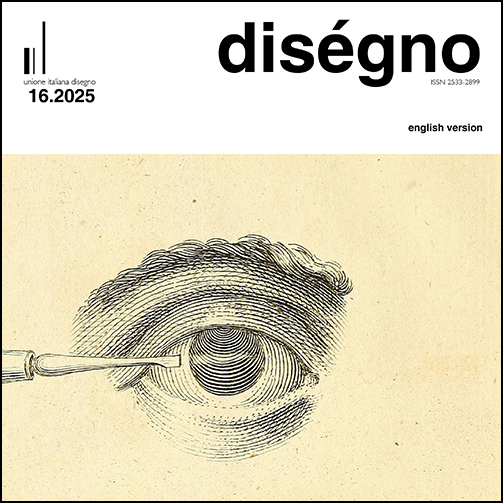Drawing and the Language of Creativity
DOI:
https://doi.org/10.26375/disegno.16.2025.7Keywords:
cognition, communication, electroencephalography, freehand, CADAbstract
This paper examines the communication of cognitive and emotional elements between a drafter and an observer through drawings.
Although this topic has been explored from philosophical and psychological perspectives, it still lacks sufficient scientific evidence to determine its biological foundations. Electroencephalography (EEG) is now a recognized instrumental tool that can be used to assess the cognitive and emotional engagement of both the drawing’s creator and its viewer. This study reports the results of experiments
in which EEG recordings were made from four subjects who acted as both drafters and observers of drawings with presumed differences in cognitive-emotive content. As drafters, the participants were asked to create both a freehand drawing and a CAD version of an architectural landscape. It was hypothesized that the freehand version would carry a stronger cognitive-emotive charge than
the CAD one. Qualitative and quantitative analyses of the EEG data showed that both drafters and observers exhibited parallel responses to the same image. These findings provide experimental support for the theory that specific feelings and perceptions of the drafter are transmitted to the observer, who responds as if him/herself were the author of the drawing.
References
Carrillo de Albornoz, C., Calatrava, S. (2018). Santiago Calatrava: Drawing, building, reflecting. New York: Thames & Hudson Inc.
Cennini, C. (1821). Di Cennino Cennini Trattato della Pittura, messo in luce la prima volta con annotazioni dal cavaliere Giuseppe Tambroni. Roma: Co’ torchj di Paolo Salviucci.
da Vinci, L. (1817). Trattato della pittura di Lionardo da Vinci tratto da un codice della Biblioteca Vaticana e dedicato alla maestà di Luigi XVIII, Re di Francia e di Navarra, a cura di Guglielmo Manzi. Roma: Stamperia De Romanis.
Freiwald, W.A., Tsao, D.Y. (2014). Neurons that keep a straight face. In Proceedings of the National Academy of Sciences, No. 111(22), pp. 7894-7895. <https://doi.org/10.1073/pnas.1406865111> (accessed 13 January 2025).
Gross, C.G. (2002). Genealogy of the “Grandmother Cell”. In The Neuroscientist, No. 8(5), pp. 512-518. <https://doi.org/10.1177/107385802237175> (accessed 13 January 2025).
Harmony, T. (2013). The functional significance of delta oscillations in cognitive processing. In Frontiers in Integrative Neuroscience, No. 7, pp. 1-10. <https://doi.org/10.3389/fnint.2013.00083> (accessed 26 January 2025).
Kilpeläinen, M., Georgeson, M.A. (2018). Luminance gradient at object borders communicates object location to the human oculomotor
system. In Scientific Reports, No. 8(1), pp.1593.1-1593.11. <https://doi.org/10.1038/s41598-018-19464-1> (accessed 13 January 2025).
Leandri, G., Schenone, A., Leandri, M. (2021). Detection of movement related cortical potentials in freehand drawing on digital tablet. In Journal of Neuroscience Methods, No. 360, pp. 109231.1-109231.12. <https://doi.org/10.1016/j.jneumeth.2021.109231> (accessed 4 November 2025).
Leandri, G., Iñarra Abad, S., Juan Vidal, F., Leandri, M. (2022). El cerebro del arquitecto y la mano pensante. In EGA Revista de Expresión Gráfica Arquitectónica, No. 27(46), pp.184-193. <https://doi.org/10.4995/ega.2022.18434> (accessed 10 December 2025).
Luck, S.J. (2014). An introduction to the event-related potential technique. New York: The MIT Press. [Fist ed. New York: MIT Press 2005].
Marrocco, R.T., Li, R.H. (1977). Monkey superior colliculus: Properties of single cells and their afferent inputs. In Journal of Neurophysiology, No. 40(4), pp. 844-860. <https://doi.org/10.1152/jn.1977.40.4.844> (accessed 13 January 2025).
Merleau-Ponty, M. (1996). Eye and mind. In G.A. Johnson (Ed.). The Merleau-Ponty Aesthetics Reader, pp. 121-149. Evenston: Northwestern University Press. <https://pg2009.wordpress.com/wp-content/uploads/2009/05/eye-and-mind-merleu-pontymmp-text1.pdf> (accessed 22 January 2025).
Orth, D., Van Der Kamp, J., Memmert, D., Savelsbergh, G.J.P. (2017). Creative motor actions as emerging from movement variability. In
Frontiers in Psychology, No. 8, pp. 1903.1-1903.8. <https://doi.org/10.3389/fpsyg.2017.01903> (accessed 13 January 2025).
Pallasmaa, J. (2009). The thinking hand: Existential and embodied wisdom in architecture. Chichester: Wiley.
Shibasaki, H., Hallett, M. (2006). What is the Bereitschaftspotential? In Clinical Neurophysiology, No. 117(11), pp. 2341-2356. <https://doi.org/10.1016/j.clinph.2006.04.025> (accessed 13 March 2025).
Sobinov, A.R., Bensmaia, S.J. (2021). The neural mechanisms of manual dexterity. In Nature Reviews Neuroscience, No. 22(12), pp. 741-757. <https://doi.org/10.1038/s41583-021-00528-7> (accessed 13 January 2025).
Downloads
Published
How to Cite
Issue
Section
License
Copyright (c) 2025 diségno

This work is licensed under a Creative Commons Attribution 4.0 International License.






